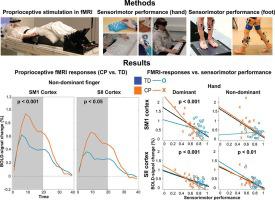NeuroImage: Clinical ( IF 3.4 ) Pub Date : 2021-08-21 , DOI: 10.1016/j.nicl.2021.102795 Timo Nurmi 1 , Julia Jaatela 2 , Jaakko Vallinoja 2 , Helena Mäenpää 3 , Harri Piitulainen 4

|
Cerebral palsy (CP) is a motor disorder where the motor defects are partly due to impaired proprioception. We studied cortical proprioceptive responses and sensorimotor performance in adolescents with CP and their typically-developed (TD) peers. Passive joint movements were used to stimulate proprioceptors during functional magnetic resonance imaging (fMRI) session to quantify the proprioceptive responses whose associations to behavioral sensorimotor performance were also examined.
Twenty-three TD (15 females, age: mean ± standard deviation 14.2 ± 2.4 years) and 18 CP (12 females, age: mean ± standard deviation, 13.8 ± 2.3 years; 12 hemiplegic, 6 diplegic) participants were included in this study. Participants’ index fingers and ankles were separately stimulated at 3 Hz and 1 Hz respectively with pneumatic movement actuators. Regions-of-interest were used to quantify BOLD-responses from the primary sensorimotor (SM1) and secondary (SII) somatosensory cortices and were compared across the groups. Associations between responses strengths and sensorimotor performance measures were also examined.
Proprioceptive responses were stronger for the individuals with CP compared to their TD peers in SM1 (p < 0.001) and SII (p < 0.05) cortices contralateral to their more affected index finger. The ankle responses yielded no significant differences between the groups. The CP group had worse sensorimotor performance for hands and feet (p < 0.001). Stronger responses to finger stimulation in the dominant SM1 (p < 0.001) and both dominant and non-dominant SII (p < 0.01, p < 0.001) cortices were associated with the worse hand sensorimotor performance across all participants.
Worse hand function was associated with stronger cortical activation to the proprioceptive stimulation. This association was evident both in adolescents with CP and their typically-developed controls, thus it likely reflects both clinical factors and normal variation in the sensorimotor function. The specific mechanisms need to be clarified in future studies.
中文翻译:

躯体感觉皮层中更强的本体感受 BOLD 反应反映出患有和不患有脑瘫的青少年的感觉运动功能较差
脑瘫 (CP) 是一种运动障碍,其中运动缺陷的部分原因是本体感觉受损。我们研究了 CP 青少年及其正常发育 (TD) 同龄人的皮层本体感受反应和感觉运动表现。在功能性磁共振成像 (fMRI) 期间使用被动关节运动来刺激本体感受器,以量化本体感受反应,还检查了其与行为感觉运动性能的关联。
23 名 TD(15 名女性,年龄:平均值±标准差 14.2 ± 2.4 岁)和 18 名 CP(12 名女性,年龄:平均值±标准差,13.8 ± 2.3 岁;12 名偏瘫,6 名双侧瘫痪)参与者被纳入本研究. 参与者的食指和脚踝分别用气动运动执行器以 3 Hz 和 1 Hz 的频率分别进行刺激。感兴趣区域用于量化初级感觉运动 (SM1) 和次级 (SII) 体感皮层的 BOLD 反应,并在各组之间进行比较。还检查了反应强度和感觉运动性能测量之间的关联。
在 SM1 (p < 0.001) 和 SII (p < 0.05) 皮质与受影响较大的食指对侧,CP 患者的本体感受反应比 TD 同龄人更强。脚踝反应在两组之间没有显着差异。CP 组的手脚感觉运动表现较差 (p < 0.001)。主导 SM1 (p < 0.001) 和主导和非主导 SII (p < 0.01, p < 0.001) 皮质对手指刺激的更强反应与所有参与者的手部感觉运动表现较差有关。
较差的手部功能与对本体感受刺激的更强皮层激活有关。这种关联在 CP 青少年及其正常发育的对照中都很明显,因此它可能反映了临床因素和感觉运动功能的正常变化。具体机制需要在未来的研究中阐明。











































 京公网安备 11010802027423号
京公网安备 11010802027423号